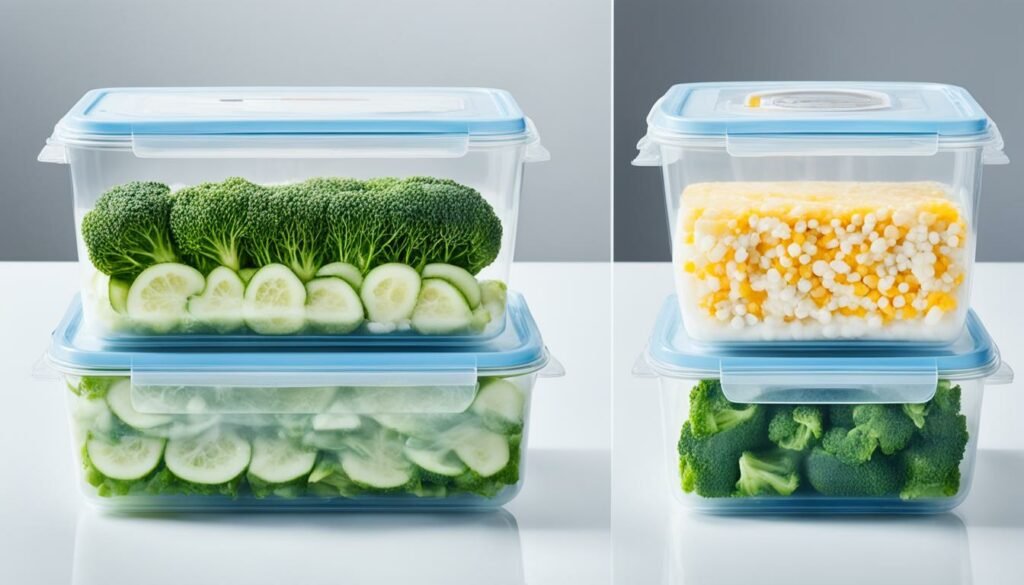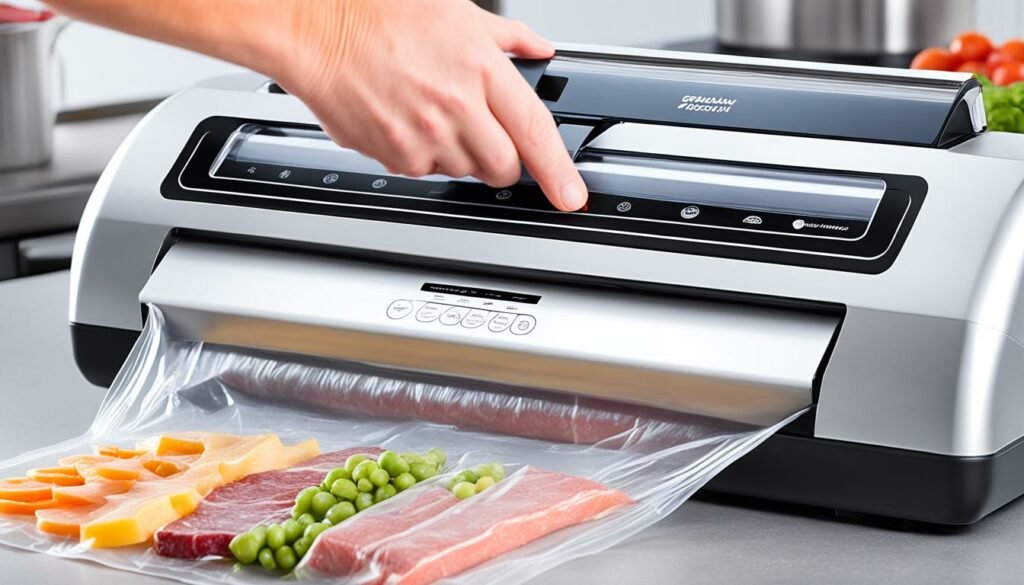I’ve often pondered the best food preservation methods for my kitchen. Exploring ways to extend shelf life and optimize storage space, two options emerge: vacuum sealing and dry storage. Both aim to keep food fresh, but they differ in their approaches.
Vacuum sealing removes air, creating a moisture barrier. On the other hand, dry storage focuses on eliminating moisture. Each method has distinct advantages, and I’m eager to discover which one excels for different foods and storage periods. Let’s delve into a comparison of these prevalent preservation techniques!
Understanding Food Preservation Methods
Food preservation is essential for maintaining the freshness and safety of our meals. This section delves into the science of food spoilage and the objectives of preservation techniques. We will examine the common methods employed to extend the shelf life of food.
The Science Behind Food Spoilage
Food spoils due to the proliferation of bacteria on its surface. These microorganisms flourish in environments with adequate light, oxygen, warmth, and moisture. To prevent spoilage, it is crucial to manage these factors effectively. Strategies such as oxygen removal and moisture prevention are integral to many preservation methods.
Goals of Food Preservation
The primary objectives of food preservation are:
- Extend shelf life
- Maintain food quality
- Ensure food safety
- Preserve nutrients
Preserving nutrients is a critical aspect of food preservation. The goal is to ensure that food remains edible for a longer period while retaining its nutritional value.
Common Preservation Techniques
Various methods exist for preserving food, each addressing different spoilage factors:
| Method | Target Factor | How It Works |
|---|---|---|
| Freezing | Temperature | Slows bacterial growth by removing warmth |
| Dehydration | Moisture | Removes water content from food |
| Vacuum Sealing | Oxygen | Removes air and creates a moisture barrier |
| Canning | Bacteria | Uses heat to kill bacteria and seals out oxygen |
Each preservation technique offers unique benefits. The optimal method depends on the food type and desired storage duration. By comprehending these techniques, I can select the most suitable approach for my food storage requirements.
Vacuum Sealing vs. Dry Storage: A Comprehensive Comparison
Preserving food effectively involves understanding the pros and cons of vacuum sealing and dry storage. This comparison aims to guide you in selecting the best cost-effective storage solutions for your situation.

Vacuum sealing is ideal for short to medium-term food preservation. It’s excellent for freezing meats and handling foods with high moisture content. By eliminating air, it prevents freezer burn and maintains food freshness. Conversely, dry storage is superior for the long-term preservation of dried goods.
To highlight the distinctions, consider the following table:
| Feature | Vacuum Sealing | Dry Storage |
|---|---|---|
| Best for | Meats, vegetables, wet foods | Grains, beans, dried foods |
| Storage duration | Short to medium-term | Long-term |
| Equipment needed | Vacuum sealer, bags | Airtight containers, oxygen absorbers |
| Space efficiency | High | Moderate |
When deciding between vacuum sealing and dry storage, evaluate the food type and its storage duration. For those preparing for potential food shortages, combining both methods could be beneficial. Vacuum sealing dry goods adds an additional barrier against spoilage.
The choice between vacuum sealing and dry storage hinges on your specific requirements. Both approaches are effective in maintaining food freshness and safety for consumption.
The Ins and Outs of Vacuum Sealing
Vacuum sealing has revolutionized food preservation. It’s proven to be an effective way to extend the shelf life of food. Let’s explore the mechanics behind this method, its advantages, and its limitations.
How Vacuum Sealing Works
Vacuum sealing uses specialized machines to remove air from food packages. This action eliminates oxygen, the primary cause of food spoilage. By removing oxygen, it effectively keeps refrigerated, dried, and frozen foods fresh.

Advantages of Vacuum Sealing
The benefits of vacuum sealing are numerous:
- Extended shelf life of foods
- Preservation of food texture and flavors
- Versatility in preserving various food types
- Prevention of freezer burn
This method stands out for its ability to retain flavors. Foods stay tasting as they should for a longer time than with traditional storage.
Limitations and Considerations
Despite its many benefits, vacuum sealing has its limitations:
| Limitation | Consideration |
|---|---|
| Electricity requirement | Not suitable for off-grid situations |
| Cost of quality machines | Initial investment may be high |
| Liquid suction risk | Can lead to improper sealing |
| Not suitable for all foods | Some items may require alternative storage |
Despite these challenges, vacuum sealing remains a top choice for preserving a broad range of foods. It’s especially effective when combined with proper storage practices.
Exploring Dry Storage Methods
Dry storage is a reliable method for preserving food. It’s an excellent choice for keeping various items fresh over time. Let’s explore the techniques, benefits, and potential drawbacks of dry storage.
Types of Dry Storage Techniques
Several effective dry storage techniques are available:
- Dry canning: Heating foods like beans and grains in jars at 200°F
- Oxygen absorber packaging: Using iron powder to reduce oxygen in sealed containers
- Mylar bags: Storing food in thick, metallic bags for long-term preservation
Benefits of Dry Storage
Dry storage has many advantages for preserving food:
- Long-term preservation without electricity
- No need for refrigeration
- Effective for both small and large quantities
- Cost-effective solution for bulk food storage
Using airtight containers is crucial for dry storage success. These containers keep food fresh by blocking moisture and pests. For those looking to enhance food preservation, vacuum sealing is a great addition to dry storage methods.
Potential Drawbacks
Dry storage is generally reliable but has its limitations:
| Drawback | Description | Prevention |
|---|---|---|
| Jar breakage | Risk during heating process | Use high-quality jars and proper heating techniques |
| Food poisoning | Potential if sterilization is insufficient | Follow proper sterilization procedures |
| Limited food types | Not all foods are suitable for dry storage | Choose appropriate foods for this method |
Moisture prevention is key in dry storage. I always ensure to use desiccants or oxygen absorbers. This keeps the environment dry and extends the shelf life of stored foods.
Conclusion: Choosing the Right Preservation Method for Your Needs
Exploring food preservation methods, I’ve discovered that vacuum sealing and dry storage each offer distinct advantages. Vacuum sealing is ideal for extending the shelf life of meats and “wet” foods, suitable for short to medium-term storage. Conversely, dry storage excels in preserving dried goods for extended periods.
The choice between these methods hinges on the type of food and its intended storage duration. For freezing meats or maintaining leftovers’ freshness, vacuum sealing is superior. However, dry storage is the better option for items like grains, beans, or spices. It’s essential to align the preservation method with your specific food items and storage objectives.
Optimizing storage space is another critical consideration. Vacuum-sealed bags significantly reduce space requirements in freezers or fridges. Yet, dry storage containers might be more suitable for pantry items. Assessing your available storage conditions is vital when selecting a preservation technique.
There is no universal solution. Sometimes, a combination of methods might be the most effective approach. For those interested in expanding their preservation techniques, pickling is a valuable alternative that adds unique flavors and health benefits. By delving into these various methods, you’ll be better prepared to maintain your food’s freshness and flavor for a longer period.
FAQ
What are the main goals of food preservation methods?
The primary objectives of food preservation are to prevent bacterial growth. This is achieved by managing factors like light, oxygen, warmth, and moisture. These elements can lead to spoilage.
How do vacuum sealing and dry storage differ?
Vacuum sealing eliminates air and creates a moisture barrier. It’s ideal for short to medium-term storage of refrigerated, dried, and frozen items. In contrast, dry storage removes moisture. It’s designed for the long-term preservation of dried goods.
What are the advantages of vacuum sealing?
Vacuum sealing offers several benefits. It extends the shelf life of food, maintains its texture and flavors, and is versatile for various food types. It also controls oxygen exposure, preventing off-flavors and color changes.
What are some limitations of vacuum sealing?
Vacuum sealing has its downsides. It requires electricity, can be costly for quality sealers, and improper sealing can occur due to liquid suction during the process.
What are some common dry storage techniques?
Dry storage techniques include dry canning, oxygen absorber packaging, and using mylar bags with oxygen absorbers. Dry canning involves heating foods in jars to destroy microorganisms. Oxygen absorber packaging uses iron powder to draw oxygen molecules. Mylar bags with oxygen absorbers also help in preserving food.
What are the benefits of dry storage methods?
Dry storage methods offer several advantages. They provide long-term preservation without electricity and don’t require refrigeration. These methods are effective for both small and large quantities and are well-suited for storing dried goods.
What are some potential drawbacks of dry storage?
Dry storage has some potential drawbacks. Jar breakage can occur during heating, and insufficient sterilization may lead to food poisoning. Additionally, these methods are limited in the types of food they can preserve.
